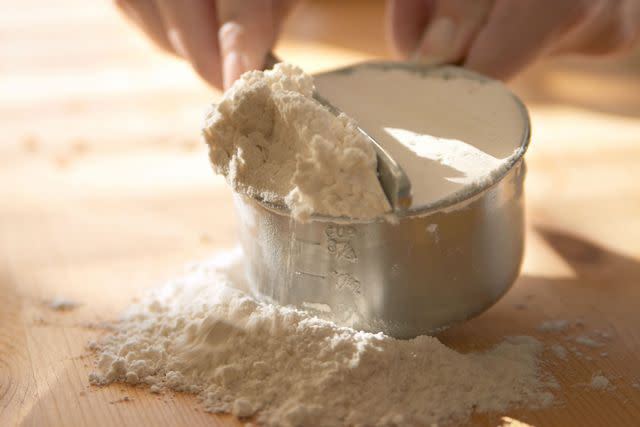How To Measure Flour Correctly And Why It Matters
Yes, there is a wrong way to measure flour—and it can be detrimental to the baking process.
Fact checked by Elizabeth BerryMedically reviewed by Carolyn O'Neil, MS, RDN
If cooking is an art, then baking is a science. Cooking and baking require different skillsets. Generally speaking, cooking is about spontaneity and touch, while baking requires precision and exactitude.
Baking relies on a series of chemical reactions that result from manipulating certain ingredients and quantities—changing just one factor can result in an entirely different product. That is why it's crucial to ensure that you're using the exact quantities called for in a recipe. Specifically, altering the quantity or type of flour can completely derail your baking project; adding a little too much flour can lead to dry, crackly bread dough, thick, tasteless cookies, or gummy cake.

Measuring the correct quantity of flour can be tricky because there are right and wrong methods. Don't fret: We're here with two easy techniques for correctly measuring flour (one using a food scale—our preferred method—and one using measuring cups) to help you bake with confidence.
How to Measure Flour with a Food Scale
The most accurate way to measure flour is with a food scale. As opposed to cup measures, which can result in inconsistencies, a food scale measures quantities down to the gram. To measure flour with a food scale, place an empty bowl on your food scale and be sure to click "zero" or "tare" before adding any ingredients; this zeroes out the weight of the bowl, ensuring that you're only counting the weight of the ingredient. Pour your flour into the bowl until you reach the desired quantity. If you're mixing more dry ingredients right in with the flour, feel free to tare the scale again and measure the remaining ingredients directly into the bowl.
How to Measure Flour with Measuring Cups
If you don't have a food scale, there is another technique to ensure that you're getting the most accurate measurement of flour. If you simply scoop flour out of the bag with the measuring cup, you're actually packing more flour into the cup than you may need. The difference can be quite dramatic. By packing the flour into the cup, you can end up with up to 50 percent more than necessary.
Our preferred technique for measuring flour is the scoop and level. Use a large spoon to scoop flour out of the bag and deposit it in a measuring cup. Do not pack or press the flour down; simply let it fall into the measuring cup. Continue scooping until you've filled the measuring cup, then use the back of a butter knife to level off the top (without pressing it down).
This is a core technique to keep in your baking repertoire and pass on to future generations.
How to Measure Sifted Flour
Some baking recipes call for sifted flour because it removes clumps and ensures a more accurate measurement. The trick is whether to measure before or after sifting. For recipes that call for sifted flour, first sift the flour into a bowl, then spoon the needed amount into a measuring cup and level. Many recipes don’t require sifted flour anymore because most flour brands are pre-sifted during production, and stirring the flour before spooning it into a measuring cup is enough to keep it from compacting. Recipes that do require sifting are more likely to be delicate, airy desserts like angel food cake. If your flour hasn’t been used lately or is still in the paper package it came in, it’s a good idea to stir or whisk it to incorporate air before using.
Put the Methods to Work
Now that you know how to avoid measurement mishaps, you can replicate your bakery favorites and get satisfying results. Bread recipes—from soft sandwich bread to crusty loaves—rely on those exact flour measurements. Our Orange Chiffon Cake gets its light, airy texture from sifted cake flour. Classic cookies and edible cookie dough will taste better with the precise amount of flour, too.
What are you waiting for? It's time to get baking.
For more Southern Living news, make sure to sign up for our newsletter!
Read the original article on Southern Living.

